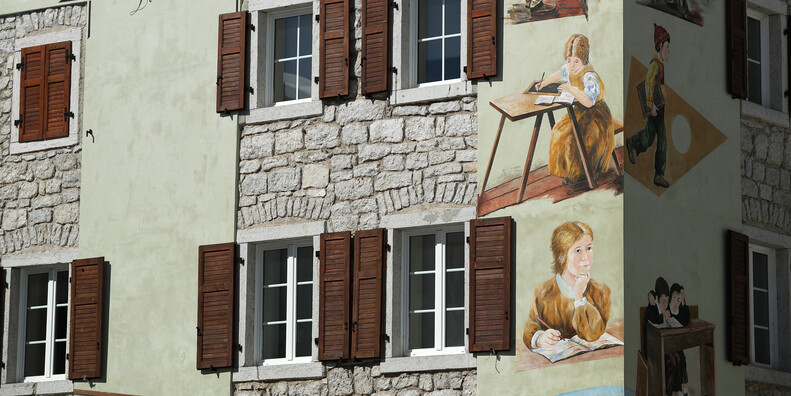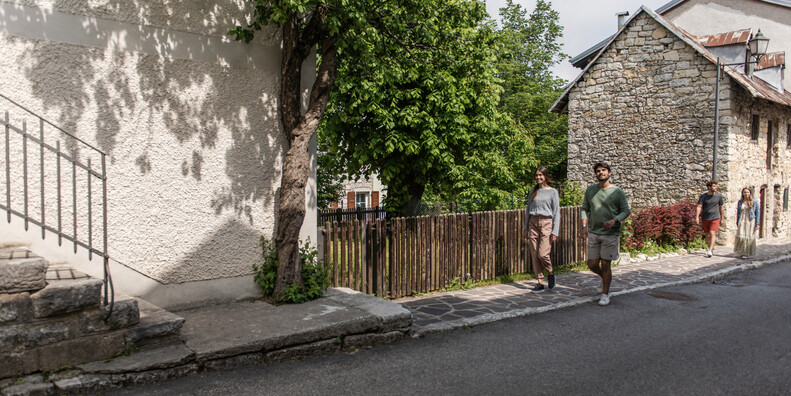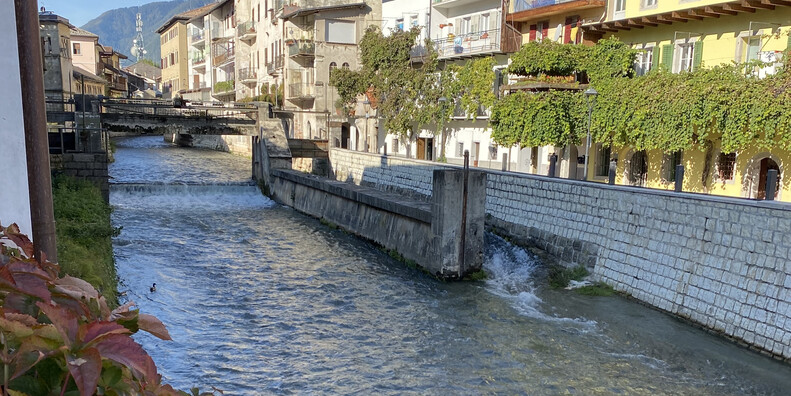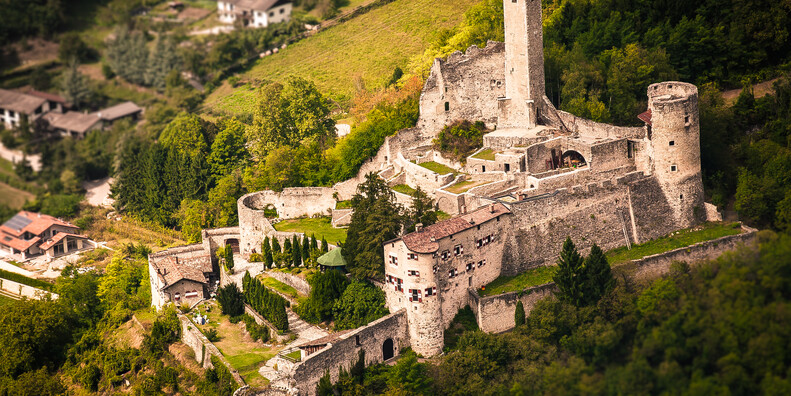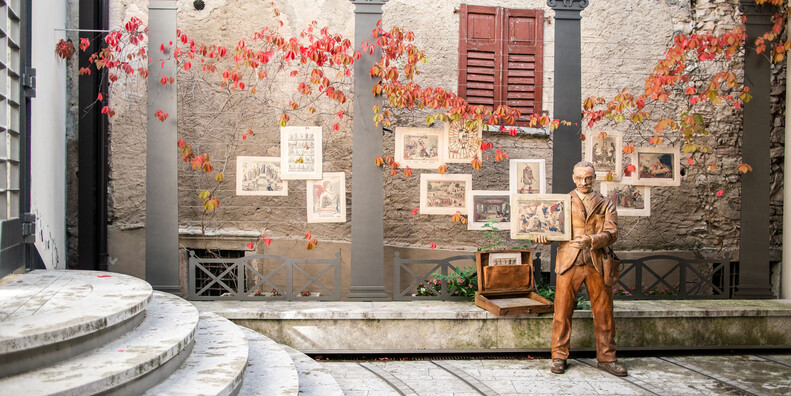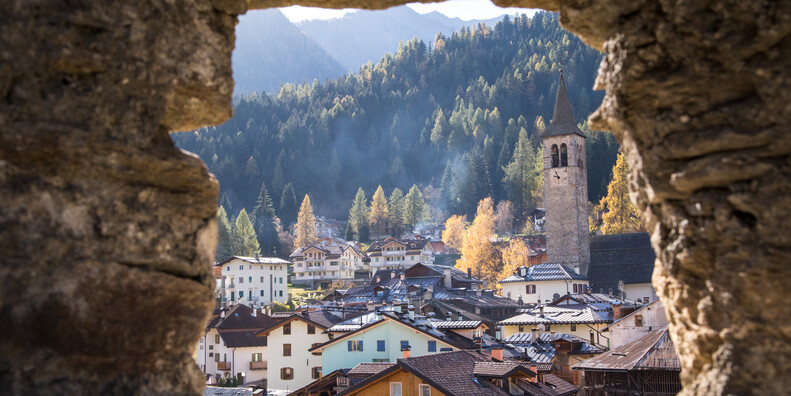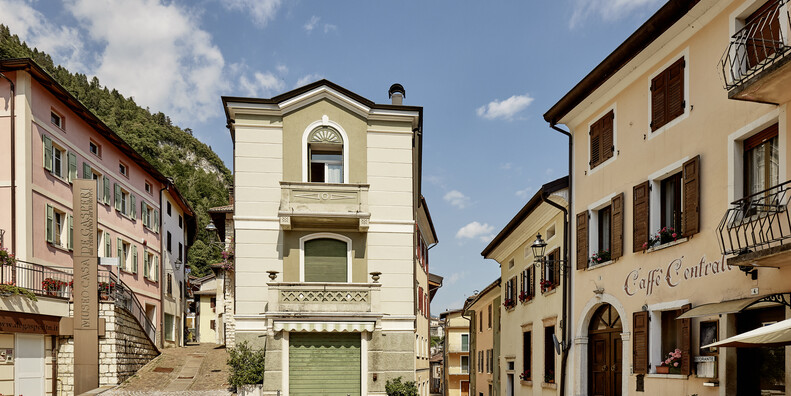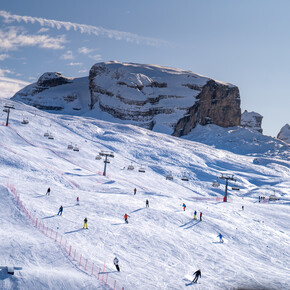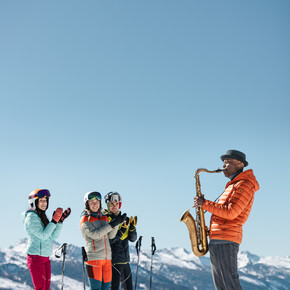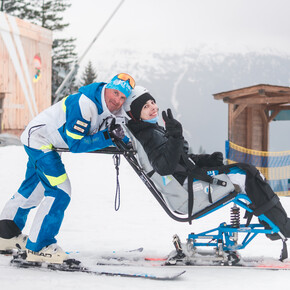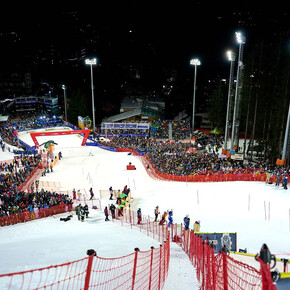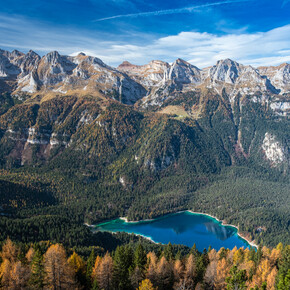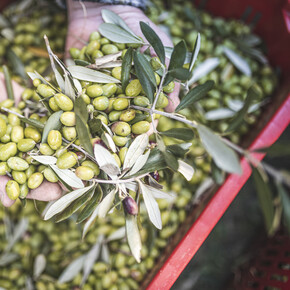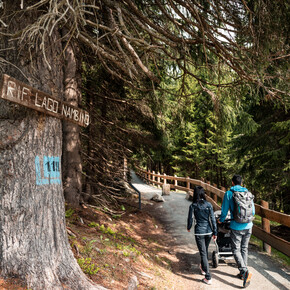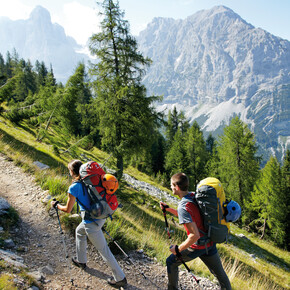DISCOVERING THE MOST BEAUTIFUL VILLAGES
Ten villages in Trentino are included in the list of the Most Beautiful Villages in Italy: in the Giudicarie and in the upper Garda, in the Valle del Chiese and the Dolomite valleys, and in Valsugana, Alpe Cimbra and Val di Sole. So too are there plenty of journeys of discovery into traditions, ancient stones, rural architecture and signs of the sacred
Secluded in the mountains, almost as if seeking reassuring protection, surrounded by woods or stretches of cultivated land that over the centuries have been a source of survival for their communities, the villages of Trentino open their doors, letting their courtyards, with their typical stone fountains, frescoes and signs of the sacred on their façades, porticoes, barns and wooden balconies where ears of corn or walnuts are still dried, tell their own story.
San Lorenzo, a village of well-being. Situated at the foot of the Brenta Dolomites, this village was created through the union seven villas: Berghi, Pergnano, Senaso, Dolaso, Prato, Prusa and Glolo. Walking leisurely through the narrow streets of the seven hamlets, you can still admire rare examples of rural architecture with unique architectural elements such as “pont”, ramps for vehicles to access the hay stores, drying rooms and haylofts in the upper part of the dwellings. As if to emphasise the relaxing power of this village, you’ll also find yogi masters and other wellness practitioners based here. San Lorenzo is also home to “ciuiga”, a Slow Food Presidium sausage to which an entire weekend of festivities at the height of autumn is dedicated. You can sample it at the Ristoro Dolomiti di Brenta, at the gateway to the Val d’Ambièz, perhaps after a hike.
Rango, a rural heartland. Climbing towards the Bleggio plateau with its ancient parish churches, through a rural landscape shaped by mountain potato farming, you come to Rango. The “Portech de la Flor” is the first traditional dwelling that will catch your eye. It is the oldest and most monumental core of the village, a model for all the other “porteghi” that have embellished the hamlet over time. Porticoes, wine cellars, entrance ways, large fountains and stone fences, cobbled streets and ancient dwellings can be seen in the heart of the village. A true compendium of rural architecture in the Giudicarie area, which seems to live in that past of shepherds, flocks, pilgrims, merchants and travellers. A few minutes’ walk separates the village of Rango from Balbido, the “painted village”, owing to the colourful murals that decorate its houses. The Bleggio walnut, now a Slow Food presidium, is the basis of many tasty local recipes and there is even an easy walk dedicated to it, which follows country roads through meadows and cultivated fields. If you fancy a slice of walnut cake baked in a wood-fired oven, head to Panificio Riccadonna, or in the nearby village of Cavrasto, visit l’Azienda agricola Il Noce, which specialises in products made from Bleggio walnuts, sweets, pesto, oil and more.
Canale di Tenno, the medieval village. You can stroll along the cobbled lanes overlooked by the distinctive outlines of the old stone houses, passing under arches, arcades and thick walls that connect the houses to one another. One of the landmarks in the village, which is also known internationally, is the Giacomo Vittone “Casa degli Artisti” (House of Artists), which hosts exhibitions and art events from March to December. The Locanda del Borgo in the central square is the perfect place to have a snack and try the real speciality of this area, carne salada (salted meat), and its ideal accompaniment, fasoi (beans), or other zero-kilometre dishes. An alternative is the Antica Croce Restaurant in Tenno.
Bondone, the village above the clouds. The southernmost municipality in the Valle del Chiese, overlooking the northern shores of Lake Idro, on the border with Lombardy, this village started life as a community of charcoal burners. Walking through its narrow, indeed very narrow, streets, passing under arches, taking paths that turn into steep steps between houses, brushing against moss-covered dry-stone walls, admiring the frescoes that decorate some of the houses such as the “Madonna Enthroned” (16th century), is like going back in time to distant, harsh seasons. That is, when charcoal burners and their families only lived here for four months of the year, and during the remaining months it was deserted, sinking into silence. Don’t miss a visit to the nearby Castel San Giovanni, clinging to the rocks. For a break with a view of Lake Idro, try Restaurant Pizzeria Miralago in the hamlet of Baitoni. Along with fish dishes, you can sample polenta made with the famous yellow flour of Storo, an iconic product of the Valle del Chiese.
Mezzano, for a romantic getaway. Nestled in the Primiero valley, with its artistic wooden architecture and views of the Dolomites, this village is a treasure trove of alpine life and an inexhaustible mine of ideas that come to life for visitors in the most hidden corners: along the narrow streets (the “canisele”), in little squares and in the shade of balconies in this unique, vibrant museum under the sky. It’s a place to visit simply by walking along a number of themed routes that encourage you to look for “scattered signs of the countryside” among the houses, especially the famous woodpiles, which are turned into works of art here thanks to the Cataste&Canzei initiative. At the Caseificio di Primiero dairy, you can buy the famous tosèla, a fresh cheese typical of this area, and in summer, Botìro di Malga butter. After a tour of the village, you can stop at Ristorante la Lontra.
Vigo di Fassa, at the foot of King Laurin’s castle. The Trentino Dolomites is home to another “Most Beautiful Village in Italy”, a cradle of Ladin culture at the foot of the Catinaccio-Rosengarten Group, a UNESCO World Heritage Site, which legend has it was home to Laurin, king of the dwarves. At the entrance to the village of Vigo is the Ladin Museum, whose collections house the heritage of the material culture and traditions of the Ladins of Fassa. Vigo has many hamlets, one of which is Tamiòn, a small inhabited centre 4 km from the town where there is a small church dedicated to the Holy Trinity among the houses with historic barns. The Gothic shrine of Santa Giuliana is one of the oldest in the valley. It is dedicated to the patron saint of the Val di Fassa and contains exquisite 15th-century fresco cycles. It stands on a prehistoric cult site, the Doss del Ciaslìr, which is also linked to events involving the witch trials that had a dramatic impact on the Fassa community in 1627-28. This area is on the Dolomites Cheese Route, which in the Val di Fassa is represented by Cher de Fascia and Puzzone di Moena. There is no shortage of these cheeses on the menus of the traditional restaurant El Tobià in Vigo and the Michelin-starred L’Chimpl in the hamlet of Tamiòn.
Luserna, a bastion of Cimbrian heritage. A handful of houses that seem as if they’re suspended when, at first light, the mists invade the Valle dell’Astico and rise up to lap the edge of the rocky spur that plunges to the west of the town into this floating sea of vapour. Luserna/Lusérn, a mountain village sitting at an altitude of 1,333 m, south-east of Trento, truly is an island – the last place where Cimbrian, an ancient Bavarian language, is still spoken by 90% of the population. In the foothills between the Adige and Brenta rivers, around 1,500 people now identify as Cimbrian, including most of the current 250 inhabitants of Luserna. Secluded and immersed in this fascinating natural setting, it is located on the central-southern border of a large alpine pastureland that stretches between Folgaria, Lavarone and Passo Vezzena overlooking the Valle dell'Astico. The Lusérn Documentation Centre/ Dokumentationszentrum Lusérn, housed in the old 19th-century German school, is responsible for the preservation and enhancement of Cimbrian culture. It is a museum with sections dedicated to history and traditions, local fauna, Bronze Age smelting furnaces and the Great War (it was in the square and church of Luserna that the first Italian bombs fell on the territories of the Austrian-Hungarian Empire at dawn on 25 May 1915). The Haus von Prükk Museum House is emblematic of the traditions of this minority: it is the result of the conservation-led restoration of an ancient farmstead in which the original features of a 19th-century rural dwelling had survived intact. After a walk through the woods around the village, you can have a rest at the Malga Campo mountain hut. At the Lusernarhof, housed in three old Cimbrian houses overlooking the Astico valley, you can sample traditional local dishes.
Pieve Tesino, the village of street vendors. The village of Pieve Tesino is famous for being the birthplace of statesman Alcide De Gasperi (1881-1954), to whom the Casa Degasperi Museum is dedicated. Pieve, so called because it has been the seat of the valley’s Chiesa Pievana (parish church) since time immemorial, extends in a fan-shape at the foot of the Bosco di Santa Maria, and is laid out on short terraces connected by cross-roads partly paved with “cobblestones” collected from the bed of the nearby Grigno stream (a tributary of the Brenta), and, in the upper part, by striking granite flights of steps. The heart of the village is Piazza Maggiore, dominated by the “dama delle fonti”, an ancient octagonal fountain in red stone. The Museo per via, inside Casa Buffa Giacantoni, displays a collection of testimonies of the epic adventures of the wandering peddlers who set off from this area to walk unimaginable routes across the continents. "Le Verde", sauerkraut prepared by shredding cabbage and putting it through a lactic fermentation process, eaten cold and seasoned, is a traditional speciality of Tesino. You can try it at the restaurant at Camping Valmalene, surrounded by greenery, or in Castello Tesino at the restaurant in Hotel Chalet Abete Rosso.
Ossana, in the shadow of the contested castle. In the upper Val di Sole, Ossana is located at the gateway to the Val di Peio, at the foot of the peaks of the Presanella Group, and is the municipal seat to which the hamlets of Fucine and Cusiano belong. From ancient times, the town of Ossana was the political, administrative and ecclesiastical centre of the upper Val di Sole, built at the confluence of the valleys of Vermiglio and Peio. Throughout the Middle Ages and into the modern age, it was a flourishing village, primarily due to ironworking in the Comasine mines in the nearby village of Fucine and trade with the nearby Lombard valleys. The village is dominated by the tower of the Castello di S. Michele, one of the most iconic places in Val di Sole, whose history is largely linked to that of the castle, often contested between the Bishop of Trent and the Count of Tyrol and inhabited by various feudal families. It sits on a hill that recent excavations have confirmed has been inhabited since the Bronze Age. Its layout is that of a classic observation outpost built at a strategic crossing point. Perhaps dating back to the Lombard period, the first known written record of it dates from 1191. Surrounded by two lines of walls and a 16th century bastion, the castle’s most striking feature is its mighty donjon. At 25 metres high, it dominates the valley and remains the best preserved architectural element of the entire complex.
Also in the heart of the village, in an 18th-century mansion, now the headquarters of the San Vigilio Foundation, you can admire the “Stuva Nova”, a room furnished with richly decorated carved wooden walls, a beautiful stove, paintings and much of the original 18th-century furniture.
At the entrance of the village, in the Park of Peace on Tomino Hill, stands the Austro-Hungarian Monumental Cemetery, where the Monument to the Austrian Kaiserschütze, the work of the sculptor Othmar Schrott-Vorst, was created in 1917. Speaking of local products, we can’t fail to mention Casolèt cheese, a typical soft mountain cheese, made from raw milk and to be eaten fresh; it has a sweet, delicate flavour and is suitable for all palates. It was the quintessential home-made cheese, consumed mainly within the family during the winter months. It is often found in local dishes that can be enjoyed at the Antica Osteria in the centre of Ossana or at the Il Mulino restaurant in Comasine di Peio.
Borgo Valsugana, between river landscapes and echoes of Veneto. The main town in the Bassa Valsugana, Borgo Valsugana offers the most interesting surviving urbanised river landscape in Trentino. Dominated by the imposing Castel Telvana, the town is crossed by the River Brenta, which has helped lend it a delightful Venetian character. The medieval character of Borgo has remained almost intact in its urban layout, featuring a maze of narrow streets, hallways and small courtyards, while austere Renaissance and Baroque palaces stand along the old imperial road. Within the town, there are many sights worth discovering, including the porticoes of the Lungobrenta, the Venetian bridge, the old Corso Ausugum with buildings from the late Renaissance and Baroque periods, churches and several squares.
Borgo Valsugana is an ideal destination for a sustainable trip. It is located on the Trento-Bassano railway line and is crossed by the Valsugana cycle path that connects Pergine and Lake Caldonazzo with Bassano del Grappa. This route of 80 km, along which culture, history and natural landscapes intertwine, straddles the Trentino and Veneto regions. A new artistic project, called Sky Museum, has been launched by Arte Sella in Borgo Valsugana: together with the Municipal Administration, three installations have been created in the old town. A treasure to be marvelled at is Castel Telvana, which dominates the village from the summit of Mount Ciolino. On Corso Ausugum (no. 21) there is an archway with the “staircase to Telvana”, which leads to the foot of the castle in less than half an hour’s walk. You can’t go inside the castle as it’s private property, but you can admire the external features – especially the high tower and mighty turrets – from several positions, including from above by walking along various paths (follow the signs marked “Passeggiata giro dei castelli”). A few kilometres from Borgo Valsugana, the woods around the town of Roncegno are the heart of chestnut production, to which a festival is also dedicated in October. You can try a selection of local dishes at Ristorante Al Legno in Val di Sella.
More information here




